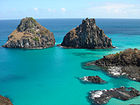discordant coast — a coast of headlands and bays where the different rock types are perpendicular to the coastline … Geography glossary
Concordant coastline — A concordant, longitudinal, or Pacific type coastline occurs where beds, or layers, of differing rock types are folded into ridges that run parallel to the coast.[1] The outer hard rock (for example, granite) provides a protective barrier to… … Wikipedia
Coast — For other uses, see Coast (disambiguation). A coastline or seashore is the area where land meets the sea or ocean.[1] A precise line that can be called a coastline cannot be determined due to the dynamic nature of tides. The term coastal zone can … Wikipedia
Headlands and bays — Main articles: Bay and Headland Headlands and bays are two related features of the coastal environment. Contents 1 Geology and geography 2 Beach stability 3 Notes … Wikipedia
Cuspate foreland — A Cuspate foreland, solidified by vegetation Cuspate forelands, also known as cuspate barriers or Nesses in Britain, are geographical features found on coastlines and lakeshores that are created primarily by long shore drift.[1] Formed by… … Wikipedia
Coastal management — This article is about coastal management aimed to prevent erosion and flooding. For broader management issues, see Integrated coastal zone management. Oosterscheldekering sea wall, the Netherlands. In some jurisdictions the terms sea defense and… … Wikipedia
Coastal erosion — Many stretches of the East Anglia, England coastline are prone to heavy levels of erosion, such as this, the collapsed section of cliffs at Hunstanton, Norfolk. Coastal erosion is the wearing away of land and the removal of beach or dune… … Wikipedia
Coral reef — Marine habitats Biodiversity of a coral reef Lit … Wikipedia
Shoal — Bar (landform) redirects here. For other uses, see Bar (disambiguation)#Landforms. Sandbank redirects here. For other uses, see Sandbank (disambiguation). For other uses, see Shoal (disambiguation). Sandbar between St. Agnes and Gugh on the Isles … Wikipedia
Modern recession of beaches — Main article: beach evolution Important segments of low coasts are receding, losing sand and reducing the beaches dimensions. This loss could occur very rapidly. From more to less natural causes (degree of anthropization downwards): Contents 1… … Wikipedia



